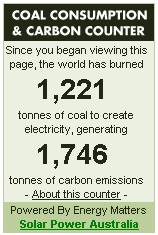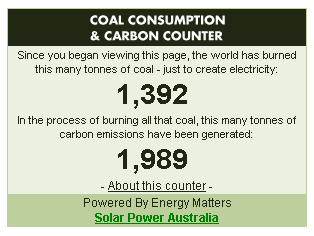The world is burning coal for electricity production at a frightening rate and the unbridled consumption is belching mercury and carbon emissions into our fragile atmosphere. What we will do on this page in the near future is install a simple and easy to ready carbon counter.
Come back soon and you can see how much coal is being burned and how much resulting carbon dioxide is being produced while you read this page.
|
Get a coal and carbon counter for your web site. |
You can do your bit to slow the counter down by switching to solar power.
About the coal count numbers
An even more frightening aspect is that the numbers above are conservative. The coal count is based on the Coal Industry Advisory Board’s International Coal Market & Policy Developments in 2009 report and applies to thermal coal only. According to the CIAB’s report, an estimated 5,000 million tonnes of thermal coal was burned in 2009. 90% of thermal coal is used for electricity production; so the counter figures are based on 4,500 million tonnes annually. With the demand for thermal coal increasing, today’s coal consumption is likely far more. Between the period 2000 – 2009, world thermal coal consumption increased by a staggering 59%!
About the carbon emission count numbers
Again, these numbers are very conservative. According to the U.S. Energy Information Administration, coal with a carbon content of 78 percent when completely combusted generates emissions in the region of 1.43 to 1; which is the ratio we based the emissions count on. In reality, with so many coal fired power stations burning low quality coal and other inefficiencies in the combustion process, the overall emissions are likely far higher. The typical carbon content for coal ranges from 60 percent for lignite (brown coal) to more than 80 percent for anthracite (hard coal).
Why do emissions weigh more than the coal being burned?
Carbon dioxide is created during coal combustion when an atom of carbon unites with two atoms of oxygen from the air drawn in for combustion, which in essence adds to the weight post-combustion.
Tonnes vs. short tons and long tons
For readers in countries not using the metric system for weights, a tonne is 2,204 pounds – so between a short ton (2,000 lbs) and a long ton (2,240 lbs), there is a 240 lb difference, just ove 100kg.
Slow the counter down!
Coal is not a cheap energy source and never has been. The real price of coal is hidden – in fossil fuel subsidies and in the debt it is racking up in terms of environmental damage and the impact on human health. When all the negative effects of coal are taken into account throughout its life cycle, it’s estimated the true cost of coal to the USA economy alone is a third to over half a trillion dollars dollars a year. Carbon emissions aren’t the only issue with coal. Burning of coal is the world’s largest contributor to atmospheric mercury levels. Mining of the fossil fuel destroys landscapes, poisons waterways and even coal ash is toxic. So-called “clean coal” is not the answer as it does nothing to address these issues; it actually adds to the problem. We all play a role in reducing the demand for coal fired power generation. By becoming more energy efficient in our homes, pushing government to implement solid renewable energy policies or even installing a home solar power system, we can reduce our personal and household’s carbon impact and contribute to wider solutions.
Get the carbon counter – it’s free
Our carbon counter makes the issue of our hyper-consumption of coal for electricity generation a little more real to those who view it. Join the revolution and be an advocate for a cleaner, renewable energy future by featuring this counter on your site – the code is below. We offer two sizes, one perfect for most side menus and another larger version more suited to be placed in a web page content area. If you don’t have a web site; let your friends know about this counter. PLEASE NOTE: The examples below are only screenshots, but when you copy the code below into your own page, the application will count up automatically, just like the one at the top of this page.
Note: the carbon counter code is currently being updated. Come back soon and we will have the very latest code for you to include on your own web site (when you do, remember to link back to Energy Matters).
 SCREENSHOT EXAMPLE (when the code is implemented on your page, the counter will update automatically) |
|
|
 SCREENSHOT EXAMPLE (when the code is implemented on your page, the counter will update automatically) |
|
|
Widget instructions
Simply click either button above and then Control + C on your keyboard, then paste the code in the source code of your page in the position where you want the counter to appear. That’s all you need to do!
Carbon counter conditions of use
All we ask is that you implement the code as is and unaltered. The links on the counter open in a new window, so you won’t lose visitors from your site
Thank you for supporting a clean, renewable energy future!









































